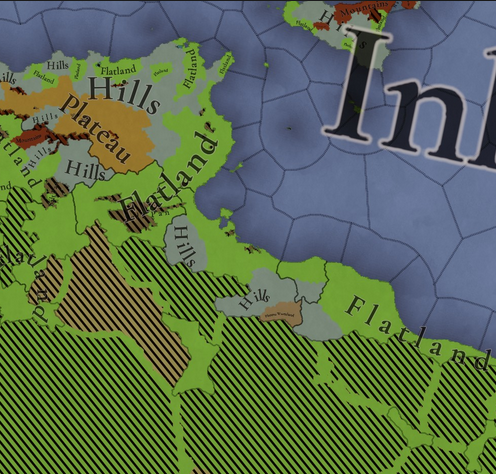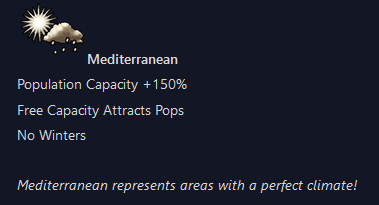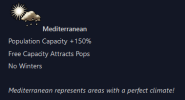Welcome to another Tinto Talks! Happy Wednesday where we talk about our super-secret game with the codename Project Caesar, asking you for feedback!
Today we’ll go into the details of how terrain works in the game. To iterate from the Map-Tinto-Talks from almost a year ago, each location has three different attributes instead of a single one as previous games had. This creates more variation and allows us more granular control over game play.
Each location has a climate, a topography and a vegetation set. Sea locations do not have vegetation though.
Climate

The climate of a location impacts how well pops can live there, including how much food can be produced. It also affects the maximum winter level of a location.
 Tropical
Tropical
Population Capacity +50%
Development Growth -10%
Life Expectancy -5
Free Capacity Attracts Pops
No Winters
Tropical represents areas with high average temperatures and no winter.
 Subtropical
Subtropical
Population Capacity +100%
Free Capacity Attracts Pops
Max Winter is Mild
Subtropical represents areas with high average temperatures and mild winters.
 Oceanic
Oceanic
Population Capacity +50%
Free Capacity Attracts Pops
Max Winter is Mild
Oceanic represents areas with mild winters but high humidity.
 Arid
Arid
Wheat Production -10%
Life Expectancy -5
Free Capacity Attracts Pops
No Precipitation
No Winters
Arid represents an area that has a severe lack of available water.
 Cold Arid
Cold Arid
Wheat Production -10%
No Precipitation
Max Winter is Mild
Cold arid represents an area that has a severe lack of available water but experiences winters.
 Mediterranean
Mediterranean
Population Capacity +150%
Free Capacity Attracts Pops
No Winters
Mediterranean represents areas with a perfect climate!
 Continental
Continental
Population Capacity +50%
Free Capacity Attracts Pops
Max Winter is Normal
Continental represents areas with cold winters.
 Arctic
Arctic
Population Capacity -55%
Development Growth -25%
Life Expectancy -5
Max Winter is Severe
Arctic represents areas with very cold winters.
Vegetation

Vegetation represents the foliage cover of a location.
 Desert
Desert
Can have Sandstorms
Movement Cost for Armies +10%
RGO Build time +50%
Road Build time +100%
Development Growth -10%
Food Production -33%
Population Capacity +10k
Deserts are barren landscapes with little precipitation and almost no potential for plant or animal life.
 Sparse
Sparse
Road Build time -10%
Population Capacity +25k
Sparse represent large flat areas of land with few or no trees.
 Grasslands
Grasslands
Food Production +10%
Population Capacity 50k
Grasslands represent terrain dominated by grass with little or no trees or shrubs.
 Farmland
Farmland
Movement Cost for Armies +10%
Road Build time +10%
Development Growth +10%
Population Capacity +100k
RGO Maximum Size +10%
Food Production +33%
Farmland represents anthropogenic terrain, devoted to crops and/or extensive pastures.
 Woods
Woods
Movement Cost for Armies +25%
Attacker Diceroll in Battle -1
Maximum Frontage in Battle -2
Road Build time +25%
Population Capacity +50k
Development Growth -20%
Food Production +10%
Blocks Vision from Adjacent Sea
Woods represent terrain with less dense vegetation than forests.
 Forest
Forest
Movement Cost for Armies +50%
Attacker Diceroll in Battle -1
Maximum Frontage in Battle -3
Road Build time +50%
RGO Build time +33%
Population Capacity +25k
Development Growth -25%
Blocks Vision from Adjacent Sea
Blocks Vision from Adjacent Land
Forest represents terrain with dense vegetation.
 Jungle
Jungle
Movement Cost for Armies +100%
Attacker Diceroll in Battle -1
Maximum Frontage in Battle -4
Road Build time +200%
RGO Build time +50%
Population Capacity +50k
Development Growth -50%
Blocks Vision from Adjacent Sea
Blocks Vision from Adjacent Land
A jungle represents terrain with dense forest and tangled vegetation that makes doing anything on the land difficult.
Topography

Topography represents the roughness and elevation of the land within a location. Flatter Topography is generally better for growing Towns and Cities while rougher Topography is easier to defend.
These first ones are land related topographies.
 Flatland
Flatland
No special attributes
Flatland represents terrain that does not have any major topographic variation, so there are no impediments for army movement or building development.
 Mountains
Mountains
Movement Cost for Armies +100%
Attacker Diceroll in Battle -2
Movement is Blocked in Winter
Maximum Frontage in Battle -4
Road Build time +200%
RGO Build time +100%
Population Capacity -80%
Development Growth -70%
Food Production -20%
Blocks Vision from Adjacent Sea
Blocks Vision from Adjacent Land
Mountain terrain has high altitude and also steep slopes with relatively few and narrow flat areas, so it is more difficult for armies to cross and fight in it, and also more difficult to develop.
 Hills
Hills
Movement Cost for Armies +50%
Attacker Diceroll in Battle -1
Maximum Frontage in Battle -3
Road Build time +50%
RGO Build time +25%
Development Growth -30%
Food Production -10%
Blocks Vision from Adjacent Sea
Blocks Vision from Adjacent Land
A terrain with hills has variations in the topography, but the slopes are not as steep nor as high as those of mountains, so the penalties are also not as bad.
 Plateau
Plateau
Movement Cost for Armies +25%
Attacker Diceroll in Battle -1
Maximum Frontage in Battle -1
Road Build time +50%
RGO Build time +25%
Development Growth -25%
Blocks Vision from Adjacent Sea
They represent relatively flat areas situated at high altitude, so they have some penalties compared to flatlands due to their elevation.
 Wetlands
Wetlands
Movement Cost for Armies +50%
Attacker Diceroll in Battle -1
Maximum Frontage in Battle -3
Road Build time +75%
RGO Build time +25%
Development Growth -30%
Food Production -10%
Wetlands are terrain that is partially flooded, generally due to being near a river, lake, or coast.
The following are the naval ones.
 Ocean
Ocean
Naval Attrition +1%
This is the open seas between the continents, where only the best of ships can travel.
 Deep Ocean
Deep Ocean
Naval Attrition +2%
This is the open seas between the continents, where only the best of ships can travel, in the furthest areas from any coast.
 Coastal Ocean
Coastal Ocean
No special attributes
This is the open seas between the continents, where only the best of ships can travel, but in the areas closer to the coast.
 Inland Sea
Inland Sea
Can Freeze over during winter
Inland seas represent the land-enclosed seas like the Mediterranean or the Baltic.
 Narrows
Narrows
Can Freeze over during winter
Movement Cost for Navies +20%
Attacker Diceroll in Battle -1
Maximum Frontage in Battle -2
Blocks Vision from Adjacent Sea
Narrows are areas of sea with proximity of coast on many sides, like straits or the sea inside archipelagos, where there is not much space for movement.
Lakes, Salt Pans and Atolls exists, but are just graphical variants of Coastal Oceans, even if lakes could freeze over during winter.
Stay tuned, as next week we’ll delve into the wonderful world of military objectives.
Today we’ll go into the details of how terrain works in the game. To iterate from the Map-Tinto-Talks from almost a year ago, each location has three different attributes instead of a single one as previous games had. This creates more variation and allows us more granular control over game play.
Each location has a climate, a topography and a vegetation set. Sea locations do not have vegetation though.
Climate

The climate of a location impacts how well pops can live there, including how much food can be produced. It also affects the maximum winter level of a location.

Population Capacity +50%
Development Growth -10%
Life Expectancy -5
Free Capacity Attracts Pops
No Winters
Tropical represents areas with high average temperatures and no winter.

Population Capacity +100%
Free Capacity Attracts Pops
Max Winter is Mild
Subtropical represents areas with high average temperatures and mild winters.

Population Capacity +50%
Free Capacity Attracts Pops
Max Winter is Mild
Oceanic represents areas with mild winters but high humidity.

Wheat Production -10%
Life Expectancy -5
Free Capacity Attracts Pops
No Precipitation
No Winters
Arid represents an area that has a severe lack of available water.

Wheat Production -10%
No Precipitation
Max Winter is Mild
Cold arid represents an area that has a severe lack of available water but experiences winters.

Population Capacity +150%
Free Capacity Attracts Pops
No Winters
Mediterranean represents areas with a perfect climate!

Population Capacity +50%
Free Capacity Attracts Pops
Max Winter is Normal
Continental represents areas with cold winters.

Population Capacity -55%
Development Growth -25%
Life Expectancy -5
Max Winter is Severe
Arctic represents areas with very cold winters.
Vegetation

Vegetation represents the foliage cover of a location.

Can have Sandstorms
Movement Cost for Armies +10%
RGO Build time +50%
Road Build time +100%
Development Growth -10%
Food Production -33%
Population Capacity +10k
Deserts are barren landscapes with little precipitation and almost no potential for plant or animal life.

Road Build time -10%
Population Capacity +25k
Sparse represent large flat areas of land with few or no trees.

Food Production +10%
Population Capacity 50k
Grasslands represent terrain dominated by grass with little or no trees or shrubs.

Movement Cost for Armies +10%
Road Build time +10%
Development Growth +10%
Population Capacity +100k
RGO Maximum Size +10%
Food Production +33%
Farmland represents anthropogenic terrain, devoted to crops and/or extensive pastures.

Movement Cost for Armies +25%
Attacker Diceroll in Battle -1
Maximum Frontage in Battle -2
Road Build time +25%
Population Capacity +50k
Development Growth -20%
Food Production +10%
Blocks Vision from Adjacent Sea
Woods represent terrain with less dense vegetation than forests.

Movement Cost for Armies +50%
Attacker Diceroll in Battle -1
Maximum Frontage in Battle -3
Road Build time +50%
RGO Build time +33%
Population Capacity +25k
Development Growth -25%
Blocks Vision from Adjacent Sea
Blocks Vision from Adjacent Land
Forest represents terrain with dense vegetation.

Movement Cost for Armies +100%
Attacker Diceroll in Battle -1
Maximum Frontage in Battle -4
Road Build time +200%
RGO Build time +50%
Population Capacity +50k
Development Growth -50%
Blocks Vision from Adjacent Sea
Blocks Vision from Adjacent Land
A jungle represents terrain with dense forest and tangled vegetation that makes doing anything on the land difficult.
Topography

Topography represents the roughness and elevation of the land within a location. Flatter Topography is generally better for growing Towns and Cities while rougher Topography is easier to defend.
These first ones are land related topographies.

No special attributes
Flatland represents terrain that does not have any major topographic variation, so there are no impediments for army movement or building development.

Movement Cost for Armies +100%
Attacker Diceroll in Battle -2
Movement is Blocked in Winter
Maximum Frontage in Battle -4
Road Build time +200%
RGO Build time +100%
Population Capacity -80%
Development Growth -70%
Food Production -20%
Blocks Vision from Adjacent Sea
Blocks Vision from Adjacent Land
Mountain terrain has high altitude and also steep slopes with relatively few and narrow flat areas, so it is more difficult for armies to cross and fight in it, and also more difficult to develop.

Movement Cost for Armies +50%
Attacker Diceroll in Battle -1
Maximum Frontage in Battle -3
Road Build time +50%
RGO Build time +25%
Development Growth -30%
Food Production -10%
Blocks Vision from Adjacent Sea
Blocks Vision from Adjacent Land
A terrain with hills has variations in the topography, but the slopes are not as steep nor as high as those of mountains, so the penalties are also not as bad.

Movement Cost for Armies +25%
Attacker Diceroll in Battle -1
Maximum Frontage in Battle -1
Road Build time +50%
RGO Build time +25%
Development Growth -25%
Blocks Vision from Adjacent Sea
They represent relatively flat areas situated at high altitude, so they have some penalties compared to flatlands due to their elevation.

Movement Cost for Armies +50%
Attacker Diceroll in Battle -1
Maximum Frontage in Battle -3
Road Build time +75%
RGO Build time +25%
Development Growth -30%
Food Production -10%
Wetlands are terrain that is partially flooded, generally due to being near a river, lake, or coast.
The following are the naval ones.

Naval Attrition +1%
This is the open seas between the continents, where only the best of ships can travel.

Naval Attrition +2%
This is the open seas between the continents, where only the best of ships can travel, in the furthest areas from any coast.

No special attributes
This is the open seas between the continents, where only the best of ships can travel, but in the areas closer to the coast.

Can Freeze over during winter
Inland seas represent the land-enclosed seas like the Mediterranean or the Baltic.

Can Freeze over during winter
Movement Cost for Navies +20%
Attacker Diceroll in Battle -1
Maximum Frontage in Battle -2
Blocks Vision from Adjacent Sea
Narrows are areas of sea with proximity of coast on many sides, like straits or the sea inside archipelagos, where there is not much space for movement.
Lakes, Salt Pans and Atolls exists, but are just graphical variants of Coastal Oceans, even if lakes could freeze over during winter.
Stay tuned, as next week we’ll delve into the wonderful world of military objectives.





